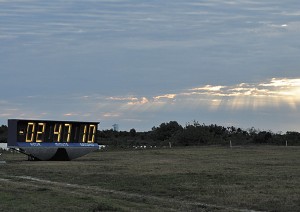NASA has done a poor job communicating the transition phase it’s experiencing since the Space Shuttle was retired in 2011. The average American thinks NASA is finished/ended/no-longer (these words have been voiced by educated Americans on more than one occasion to the writer of this article). The lull America has experienced since it lost manned access to space is not normal in our culture, but may be the best thing that ever happened in the endless quest for taking the lead in space exploration.
While the press was gathered waiting for the March 1 SpaceX launch, NASA intimately explained its goals. During the two days of tours, press conferences, special talks, and Q&A sessions, NASA employees — from mechanics to Deputy Administrator Lori Garver herself — conveyed the same message: NASA is back in the exploration and science business. In other words, NASA is no longer a taxi service. Taxi-type operations to the Space Station will be off-loaded to ambitious companies such as SpaceX, Boeing, and the Sierra Nevada corporation: three finalists chosen for the next round of Commercial Crew Development known as CCiCAP.
This new direction is probably the best thing to happen to the American vision of NASA since the glory days of the 1960s. Although times (and budgets) have changed by orders of magnitude since the 60s, NASA has a clear objective even if the agency isn’t sure where the first humans will ultimately go. While Space Station astronauts hitch rides on Soyuz rockets, several NASA manned programs continue quietly in the background. The road to this fortunate development did not come easily nor inexpensively.
The Space Shuttle, which was retired in 2011, was a dream fulfilled and unfulfilled. It never became a “cheap access to space.” The Shuttle was not a good method for getting humans nor cargo into space. Outside of cost, the system also never was as flexible as promised, nor did the destination it was created to support (the Space Station) come online until 26 years into it’s lifespan. By that time it was aging.
The Shuttle program was sold to Congress in the seventies as a $50 million/launch solution, or $1,000/lb to orbit. Each trip, however, exploded into $550+ million with 5000+ employees and a lengthy turnaround time of 45-60 days for each shuttle. After 25 years of budget-busting shuttle launches and the new money-sucking International Space Station, which had consumed billions, something had to give.
Prior to the Shuttle program retirement in 2011 much effort was put into repurposing its components, such as the Shuttle’s solid rocket boosters, engines, external fuel tank, and launch tower. This work became the Constellation program announced by President Bush in 2004. The ambitious program unfortunately never received the budget it needed for it’s timeline and goals. The current administration canceled Constellation in 2010, but compromised somewhat by keeping a key part of the program: the new Orion capsule, NASA’s capsule for sending humans back to the moon and beyond. Also, the Ares rocket morphed into the Space Launch System (SLS), a massive, Saturn V size rocket comprising Shuttle launch pieces.
The Kennedy Space Center (KSC) is currently retooling itself for the Orion and the Space Launch System (SLS), two elements that will send humans back into deep space, the moon, and maybe Mars. The timeline is somewhat lengthy: no humans to the moon until 2022. (Other private interests have since announced faster, privately-funded timelines to deep space, considering 2022 much too long a timeframe.) But the work continues at KSC for this adventure. No longer will NASA be launching crews to the Space Station: that is the province of less expensive Soyuz and ultimately private commercial outfits.
Evidence of this retooling and preparation at KSC was everywhere: existing infrastructure, no matter how large, was in the process of upgrades. This retooling effort really was the highlight of the visit. The famous crawlers that carried the Saturn V and Shuttle, for example, are being upgraded for the heavier Space Launch System rocket (50 percent heavier!); changes to the Vehicle Assembly Building so that it can handle multiple types of rockets; the famous launch pad 39 rebuilt to accommodate the new SLS rocket.
The public has been frustrated, disappointed, and vocal about NASA’s inability to send humans into space. What was communicated so clearly during this KSC visit was this: NASA’s retirement of the Shuttle and reliance on Russian launches is probably the most cost-effective and progress-beneficial decision ever. Not that it has been popular.
Curiously, a looming ‘space race’ was never mentioned during the visit to KSC, nor was its probable opponent: China.



